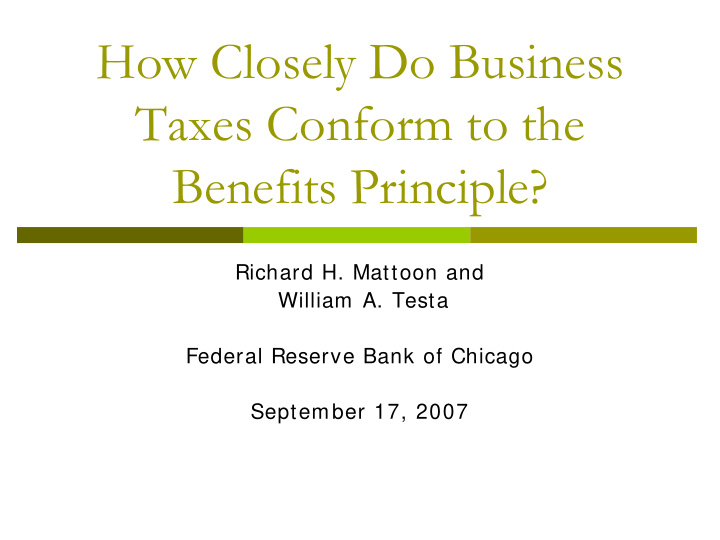



How Closely Do Business Taxes Conform to the Benefits Principle? Richard H. Mattoon and William A. Testa Federal Reserve Bank of Chicago September 17, 2007
Context � GRT’s have emerged from the dead. Ohio, Texas have recently adopted GRTs and Illinois had major GRT proposal. Why the sudden popularity? � Larger issue—the growing difficulty of taxing business. Traditional structures fail to capture revenue from new business forms such as LLPs and and S corps. � Philosophical issue—how should we tax business? What tax principles should guide the discussion?
What should guide business taxation? � Benefits principle would seem to be best candidate (Oakland and Testa). � Businesses should pay based on the benefits they receive for public services (or for their social costs). (User charges preferable) � Can you really tax business rents or export the burden? If not, over-taxing business leads to poor public choices… may over-consume government services since voters don’t think they are paying for them � Salutary effects on current development policy? � Current evidence suggests state and local business taxation is significantly too high
State & local business taxes in the United States, 2005 Percent of Percent of total Total ($ billions) business state-local taxes Property Tax $182.8 36.7 16.0 Sales Tax on Business Inputs $111.7 22.5 9.8 Excise and Gross Receipts $63.7 12.8 5.6 Corporate Income $42.1 8.5 3.7 Unemployment Insurance Tax $35.5 7.1 3.1 Individual Income Tax (on Pass-Through Business Income) $19.1 3.8 1.7 Licenses and Other Taxes $42.5 8.5 3.7 Total Business Taxes $497.4 100.0 43.6 Total Taxes $1140.6 -- -- Source: Ernst & Young ● Business taxes fall heavily on capital returns and investment
Composition of business taxes U.S. 2005 Licenses and Other Taxes, 8.5% Individual Income Tax (on Pass-Through Business Income), 3.8% Payroll Tax, 7.1% Property Tax, 36.8% Corporate Income, 8.5% Excise and Gross Receipts, 12.8% Sales Tax on Business Inputs, 22.5% Source: Ernst & Young
Business Share of Total Taxes BEA Regions 2005 70% 60% 50% 40% 30% 20% 10% 0% Pacific Mountain West North East North West South East South South Middle New Central Central Central Central Atlantic Atlantic England Source: Ernst & Young
Estimated tax rates for a hypothetical single tax on economic activity(S/L Business taxes/GSP)
Crude estimates of benefit principle in business taxation and state-local expenditure � How much does state-local government currently spend on unpriced inputs to production? � How do these expenditures compare to current business taxation?
Methodology for estimating tax-funded expenditure In estimating “business expenditures,” we would want to exclude those expenditures already funded by user fees and by the federal government. Step 1: Deriving tax-funded expenditures State-local User Tax-funded Intergovernmental expenditure charges by expenditures grants by category by category category ( un-allocated) Step 2: Parsing expenditures to the household versus business sector
Result from step 1: Tax-funded state-local expenditures to be allocated to businesses and households, FY 2005 Spending category Total ($ millions) Share of Total (percent) Education 512,189 42.24 Libraries 7,078 0.58 Housing and community development 4,949 0.41 Natural resources (fish + forestry) 3,961 0.33 Natural resources n.e.c. 10,951 0.90 Parks and recreation 19,820 1.63 Sewage 3,220 0.27 Solid waste management 7,207 0.59 All other and unallocable 17,141 1.41 General interest on debt 76,823 6.34 Financial administration 32,808 2.71 General public buildings 10,300 0.85 Judicial 33,194 2.74 Other government administration (L+CS) 18,273 1.51 Corrections 57,764 4.76 Fire protection 23,445 1.93 Police 62,529 5.16 Protective inspection and regulation 11,824 0.98 Health 40,777 3.36 Hospital 23,728 1.96 Veteran services 1,349 0.11 Welfare 134,559 11.10 Air transportation 876 0.07 Highways 67,775 5.59 Parking -196 -0.02 Water transport 493 0.04 Unemployment insurance 29,816 2.46 Total 1,212,652 100.00 Source: Census Bureau
Step 2: Census Expenditure Categories as Allocated (Summary) Households Business Shared Pro-rated All other and Education Natural resources n.e.c. Sewage unallocable Solid waste Libraries Water transport General interest on debt management Housing and community Judicial Financial administration development Parks and recreation Fire protection General public buildings Other government Natural resources (fish Protective inspection administration (legislative + forestry) and regulation + central staff) Health Police Corrections Hospital Air transportation Veteran services Highways Welfare Parking Unemployment insurance
Distribution of state and local expenditures U.S. 2005 Shared business, 8.7% Prorated business, 2.0% Business, 0.9% Shared household, 8.7% Prorated household, 15.5% Households, 64.2% Source: Census Bureau
Result: Ratio of Business Taxes to Business Expenditures– U.S. Average 1.0 Full allocation Plus 10% Education Plus 25% Education Plus 50% Education 0 0.5 1 1.5 2 2.5 3 3.5 4 Ratio Source: Ernst & Young\ Census Bureau
Business Tax/Benefit by State 2005 (ranked) Source: Ernst & Young\ Census Bureau
Map of taxes levied vs benefits received
Conclusion � States are trying to find appropriate tax structures for a shifting economy—particularly taxing services, and are turning to what look like “business taxes” � The current structure of business taxation is skewed toward capital returns and usage; they do not fare well against a benefits principle yardstick � VAT-type business tax approach would be the better option, particularly if the rates are set based on benefits received… � Based on benefits principle estimates of current business taxation, income and consumption taxes should be considered to fund state-local spending
Recommend
More recommend